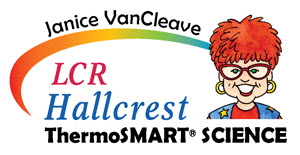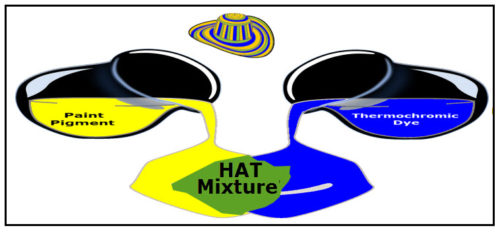Hi,
I’ve been experimenting with color changing thermochromic chemicals. These chemicals change color with variations of temperatures. Since thermochromic inks are expensive, I mixed less expensive acrylic paint with the thermochromic paint.
Note that I named the combination of a Heat Activated Thermochromic ink with acrylic paint “HAT Mixture.”
One HAT mixture was a combination of yellow paint with blue heat activating thermochromic ink. As shown in the diagram, the color of the mixture was green. My first experiment was painting the HAT Mixture on white paper. After the mixture dried, I was able to heat the paper with my hands as well as put it in the Sun. When warmed, the green color disappeared and the yellow paint was visible. When the paper cooled the HAT mixture returned to its green color.
WHY?
I love color changing chemical reactions, especially if they are reversible like the HAT mixtures I designed. But, I always want to know how it happens. With some research, I discovered that the thermochomic dye molecules actually change physical shape at different temperatures. Know that color is how you perceive the light
One of my first investigations was to paint yellow/orange imitation maple leaf with a dark blue thermochromic ink. After drying the leaf, I placed the blue leaf between the palms of my hands. Within a few seconds the blue disappeared and the original bright yellow/orange colors were again visible.
The leaf was warmed by my hands, but as soon as it cooled back to room temperature, the color reverted back to dark blue. The thermochromic ink I used was reversible, and will repeatedly change colors with changes in temperature.
How long this color change will happen is something I’ve not yet discovered. I have leaves I painted about 12 months ago and they still work well. My research indicates that exposure to UV light can chemically change the ink. This might be a topic for a science project idea.
The “Blue Leaf” experiment is applicable with different ages. Of course very young children need more one-on-one help but they love seeing the leaf change colors in their hands. Recently I used the colored leaf with 5th grade students. My aim was for the kids to make an observation then give hypotheses to explain the results. I placed the blue leaf in my hands and exaggerated pressing my hands together, then asked, “What caused the leaf to change colors?”
Answer: The leaf has some color changing paint on it.
My response was, “Great answer. I need to revise my question.”
“What activated the chromic (color changing) paint causing it to change color?”
Answers included, pressure, heat, sweat, and oil. With these answers we were ready to test the different hypotheses. Kids designed ways to test the different variables, one at a time. They identified problems, such as how to test the effects of pressure without heating the leaf and vice versa.
Once it was determined that heat is the color changing variable, I introduced the word thermochromic. I asked what chemical might be called if it changed colors in response to light. I asked them to think of a prefix that mean light. PREFIX? WOW! Confirmation that all that English “stuff” is needed. Even scientists need to know about prefixes. Yes, we finally identified chromic chemicals activated by light as being photochromic.
At some time the chromic materials were identified as Leuco dyes, which change molecular shape causing color changes.
Thermochromic Color Changing Stickers
Since coloring the leaf I’ve mixed the chromic chemicals with acrylic art paints creating colored stickers. Some stickers change color when heated, thus they are called heat activated thermochromic stickers or HAT Stickers.
To purchase color changing stickers, see Heat Activated Stickers
For fun investigations using the color changing stickers, see HAT Stickers on this website.
Other thermochromic stickers change color when cooled, thus are cold activated thermochromic stickers or CAT Stickers.
Tp purchase CAT Stickers, see Cold Activated Stickers
For fun investigations using the color changing CAT stickers, see CAT Stickers on this website.
Photochromic Color Changing Stickers
The JVC Photochromic Stickers are called SA (Sun Activated) Stickers. Technically, it is the ultraviolet light in sunlight that activates the Leuco dye causing it to change shapes. As with thermochromic leuco dyes, one shape is transparent to visible (white) light and the other shape absorbs some of the light and reflects some of the light. It is the reflected light gives the dye color.
To purchase SA Stickers, see Sun Activated Stickers
Thermochromic Liquid Crystals (TLC)
The JVC thermochromic stickers at this time is a dot sticker coated with liquid crystals.https://www.thermometersite.com/specialty-inks
To purchase liquid crystals dots, see Thermochromic Liquid Crystal Dot Stickers
For fun investigations using the TLC Dot Stickers, see, JVC TLC Dot Stickers on this website.

